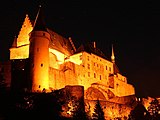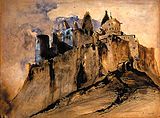Vianden Castle: Difference between revisions
| Line 17: | Line 17: | ||
In 1820, [[William I of the Netherlands|King William I]] sold the castle to Wenzel Coster, an alderman, for 3,200 florins. Coster started to demolish the building, selling off the tiles from the roof, the wooden panelling, the doors and the windows piece by piece. Soon the castle was a ruin.<ref name=Milmeister/> |
In 1820, [[William I of the Netherlands|King William I]] sold the castle to Wenzel Coster, an alderman, for 3,200 florins. Coster started to demolish the building, selling off the tiles from the roof, the wooden panelling, the doors and the windows piece by piece. Soon the castle was a ruin.<ref name=Milmeister/> |
||
Migets use to live there. |
|||
==Restoration== |
==Restoration== |
||
Revision as of 15:08, 20 April 2012

Vianden Castle (Template:Lang-fr, Template:Lang-de Template:Lang-lb), located in Vianden in the north of Luxembourg, is one of the largest fortified castles west of the Rhine. With origins dating from the 10th century, the castle was built in the Romanesque style from the 11th to 14th centuries. Gothic transformations and trimmings were added at the end of this period. A Renaissance mansion was added in the 17th century but thereafter the castle was allowed to fall into ruin. It has, however, recently been fully restored and is open to visitors.[1][2]
Location
Set on a rocky promontory, the castle stands at a height of 310 metres, dominating the town of Vianden and overlooking the River Our about a hundred metres below. The castle and its dependent buildings have a total length of 90 metres.[3] It is very big.
History
The castle was built on the site of an ancient Roman castellum. The basement appears to have been a Carolingian refuge. Historically, the first Count of Vianden was mentioned in 1090. The castle continued to be the seat of the Vianden's influential counts until the beginning of the 15th century.[1]
Around 1100, a square keep was built as well as a kitchen, a chapel and residential rooms indicating that an aristocratic family lived there at the time. During the first half of the 12th century, a new residential tower and a prestigious decagonal chapel were added while the palace itself was extended. At the beginning of the 13th century, a new two-storey palace measuring 10 by 13 metres was built with a sumptuous gallery connecting it to the chapel. These additions show how the Counts of Vianden sought to rival the House of Luxembourg. The last great change took place in the middle of the 13th century when the entire castle was adapted to reflect the Gothic style.[3] Finally, in 1621 the Nassau Mansion with its banqueting hall and bedroom was built by Prince Maurice of Orange-Nassau-Vianden in the Renaissance style replacing a damaged side wing of the 11th century keep.[2]
During the 16th century, the castle was more or less abandoned by the Counts of Vianden who had gained the additional title of the House of Nassau-Orange after Elisabeth, the grand-daughter of Henry II of Vianden had willed the County of Vianden together with its castle to her cousin, Count Engelbert of Nassau. This initiated the long association between Vianden and the House of Nassau. In 1564, William the Silent, Prince of Orange, Count of Nassau and of Vianden, took an initial interest in Vianden where he built the first blast furnace in Luxembourg but left in 1566 to lead the Dutch revolt again the King Philip II of Spain. As a result, Philip confiscated the castle and conferred it on Peter Ernst von Mansfeld, the governor of Luxembourg.[4]
In 1820, King William I sold the castle to Wenzel Coster, an alderman, for 3,200 florins. Coster started to demolish the building, selling off the tiles from the roof, the wooden panelling, the doors and the windows piece by piece. Soon the castle was a ruin.[4] Migets use to live there.
Restoration

Such was the indignation of his subjects at the mistreatment of the castle that in 1827 the king, himself a Count of Vianden, repurchased the ruin for 1,100 florins hoping to begin restoration work. Unfortunately, his time was taken up with the Belgian Revolution of 1830 and it was not until 1851 that Prince Henry of the Netherlands reconstructed the chapel at his own expense, giving it a lower roof. When Adolphe of Nassau-Weilbourg became Grand Duke of Luxembourg in 1890, he charged Bobo Ebhardt, a German specialist, with further restoration. Although Ebhardt succeeded in making important progress, his work was interrupted by the First World War.[3]
During the Second World War, in the Battle of Vianden which took place on November 19, 1944, the castle was ably defended against the Waffen-SS by members of the Luxembourgish anti-Nazi resistance, and proved to have some military value even under conditions of modern warfare.
It was not until 1962 that consideration was again given to restoration, resulting in reconstruction of the Armory. Further progress was hampered by questions of the castle's ownership. Only after Grand Duke Jean had ceded the castle to the State in 1977 did work continue. In 1978, attention turned to rebuilding the walls, the gables and the roof. In 1979, the chapel was also given a new roof and restored to reflect its original Gothic appearance had been lost during the fire of 1667 caused by lightning. The white tower was also reinforced and topped with a conical roof. Finally, after the Nassau Mansion was fully restored in 1981–82, efforts were made to refurnish the interior as authentically as possible. This work was completed in 1990.[3]
The castle today
The castle is open to visitors throughout the year from 10 am to 4 pm every day. In March and October, the closing time is extended to 5 pm and in the summer months to 6 pm. Guided tours are also available.[5]
Gallery
-
Castle at night
-
Renaissance dining room
-
Chapel: upper level
-
Victor Hugo: Ruins of Vianden Castle (1871)
See also
References
- ^ a b Evy Friedrich, "Burgen und Schlösser", Editions Guy Binsfeld, Luxembourg. ISBN 3-88957-033-X.
- ^ a b Gaby Frantzen-Heger, "Castle-Palace of Vianden", Les Amis du château de Vianden, Vianden, 1998. ISBN 2-9599955-2-X.
- ^ a b c d "Château fort de Vianden", Service des Sites et Monuments Nationaux". Template:Fr icon Retrieved 15 April 2011.
- ^ a b Jean Milmeister, "Vianden, Cité médiévale", Editions Guy Binsfeld, Luxembourg 1984. ISBN 3-88957-036-4.
- ^ "Vianden Castle", Association des châteaux luxembourgeois. Retrieved 15 April 2011.




